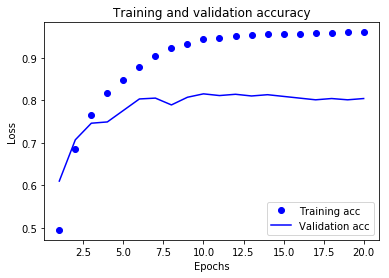本文使用的数据集是路透社数据集,包含许多短新闻以及对应的主题。路透社将新闻划分为46个互斥的主题。因为有多个类别,且每个数据点只能划分到一个类别,所以是单标签、多分类问题
准备数据
首先,加载数据
from keras.datasets import reuters
(train_data, train_labels), (test_data, test_labels) = reuters.load_data(num_words=10000)
len(train_data)
8982
len(test_data)
2246
毓IMDB数据集一样,每个样本都是一个整数列表
train_data[10]
[1,
245,
273,
207,
156,
53,
74,
160,
26,
14,
46,…
所以,我们也需要用one-hot编码处理一下:
import numpy as np
def vectorize_sequences(sequences, dimension=10000):
results = np.zeros((len(sequences), dimension))
for i, sequence in enumerate(sequences):
results[i, sequence] = 1.
return results
# Our vectorized training data
x_train = vectorize_sequences(train_data)
# Our vectorized test data
x_test = vectorize_sequences(test_data)
因为这个是多分类问题,所以我们对labels也要进行独热编码处理
def to_one_hot(labels, dimension=46):
results = np.zeros((len(labels), dimension))
for i, label in enumerate(labels):
results[i, label] = 1.
return results
# Our vectorized training labels
one_hot_train_labels = to_one_hot(train_labels)
# Our vectorized test labels
one_hot_test_labels = to_one_hot(test_labels)
内置方法
Keras的内置方法也可以实现one-hot编码操作:
from keras.utils.np_utils import to_categorical
one_hot_train_labels = to_categorical(train_labels)
one_hot_test_labels = to_categorical(test_labels)
构建网络
相比于之前的二分类问题,我们现在有了一个新的约束条件:输出类别数量从2个变成了46个,输出空间的维度变得大得多。
对于前面用过的Dense层的堆叠,每层只能访问上一层的输出信息。如果某一层丢失了毓分类问题相关的一些信息,那么这些信息无法被后面的层找回,也就是说,每一层都可能成为信息瓶颈。对于二分类问题,我们使用了16维的中间层,但对于这个例子来说16维的空间可能太小了,无法学会区分46个不同的类别。这种维度较小的层可能成为信息瓶颈,永久的丢失相关信息。
如果你把中间层设置为4个神经元,效果要比中间层为64个神经元效果差8%
from keras import models
from keras import layers
model = models.Sequential()
model.add(layers.Dense(64, activation='relu', input_shape=(10000,)))
model.add(layers.Dense(64, activation='relu'))
model.add(layers.Dense(46, activation='softmax'))
model.compile(optimizer='rmsprop',
loss='categorical_crossentropy',
metrics=['accuracy'])
对于这个例子,最好的损失函数是categorical_crossentropy(分类交叉熵),它用于衡量两个概率分布之间的距离,这里两个概率分布分别是网络输出的概率分布和标签的真实分布。
训练
x_val = x_train[:1000]
partial_x_train = x_train[1000:]
y_val = one_hot_train_labels[:1000]
partial_y_train = one_hot_train_labels[1000:]
history = model.fit(partial_x_train,
partial_y_train,
epochs=20,
batch_size=512,
validation_data=(x_val, y_val))
我们在训练数据中留出1000个样本作为验证集,之后开始训练,训练20次。
画图
import matplotlib.pyplot as plt
loss = history.history['loss']
val_loss = history.history['val_loss']
epochs = range(1, len(loss) + 1)
plt.plot(epochs, loss, 'bo', label='Training loss')
plt.plot(epochs, val_loss, 'b', label='Validation loss')
plt.title('Training and validation loss')
plt.xlabel('Epochs')
plt.ylabel('Loss')
plt.legend()
plt.show()
plt.clf() # clear figure
acc = history.history['acc']
val_acc = history.history['val_acc']
plt.plot(epochs, acc, 'bo', label='Training acc')
plt.plot(epochs, val_acc, 'b', label='Validation acc')
plt.title('Training and validation accuracy')
plt.xlabel('Epochs')
plt.ylabel('Loss')
plt.legend()
plt.show()
测试
从图中可以看出,大致网络在训练9轮之后开始出现过拟合,下面我们从新训练一个新的网络,共训练9个轮次,然后在测试集上进行评估。
model = models.Sequential()
model.add(layers.Dense(64, activation='relu', input_shape=(10000,)))
model.add(layers.Dense(64, activation='relu'))
model.add(layers.Dense(46, activation='softmax'))
model.compile(optimizer='rmsprop',
loss='categorical_crossentropy',
metrics=['accuracy'])
model.fit(partial_x_train,
partial_y_train,
epochs=8,
batch_size=512,
validation_data=(x_val, y_val))
results = model.evaluate(x_test, one_hot_test_labels)
results
得出结果是:
[0.98764628548762257, 0.77693677651807869]
这个结果,我们差不多可以得到80%的精度。
生成预测结果
predictions = model.predict(x_test)
predictions[0].shape
(46,)
predictions中的每个元素都是长度为46的向量
np.sum(predictions[0])
0.99999994
这个向量的所有元素总和为1
np.argmax(predictions[0])
3
最大的元素就是预测类别,即概率最大的类别。
注意
在模型构建的过程中,如果最后输出的层是46个输出可能,中间层的神经元最好要比46个多。否则,如果试图将大量信息压缩到一个很小的中间空间中去,可能会导致一些信息丢失。
更多精彩内容,欢迎关注我的微信公众号:数据瞎分析


